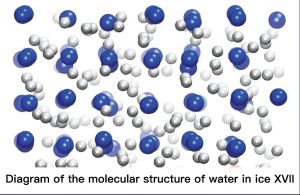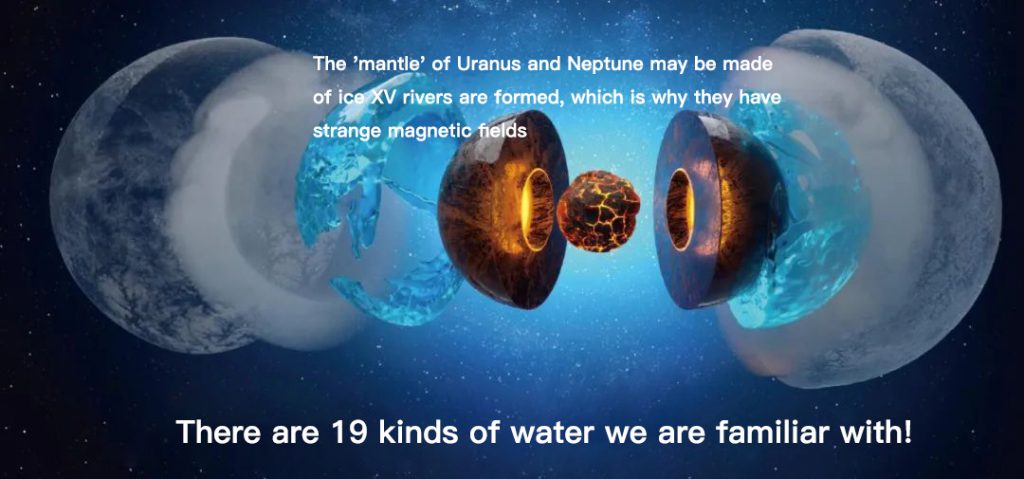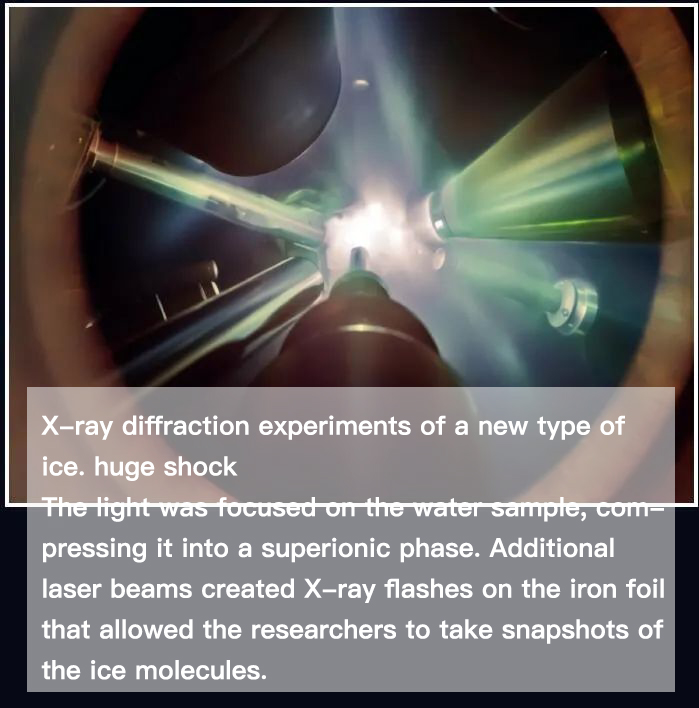
The “mantle” of Uranus and Neptune may be composed of ice XV III, which is why they have strange magnetic fields.

Ice is something we are very familiar with. When the temperature drops below 0 ℃, water will freeze into ice. But are you really familiar with ice? Do you know that so far, scientists have found 19 kinds of ice?
Ice’s “compatriots” brothers
You are right. There are indeed 19 kinds of ice on earth. In February 2021, Thomas lordin, a physical chemist at the University of Innsbruck in Austria, said that his team had produced the 19th kind of ice on earth – ice XIX. You must be surprised that the ice we usually see is not a piece of transparent and colorless solid? How are they divided into 19 species?
On the earth’s surface, the atmospheric pressure is 1.0 × 10 ^ 3 Pa (a standard atmospheric pressure), under which water will freeze at 0 ℃. But we know that with the increase of pressure, the boiling point of the object will rise. Similarly, the freezing point of the object will rise, and the atomic order inside the object will also change, which will affect the physical and chemical properties of the object. At this time, we can think that a new substance has been produced.
Ice I is the kind of ice that can be seen everywhere on the earth. The oxygen atoms are arranged in a hexagon, in which the hydrogen atoms are randomly oriented in different spatial directions, and there is no definite order among the atoms. Therefore, ice I can deform when the pressure changes, which is the reason for glacier flow. However, for ice frozen under other pressure and temperature conditions, the arrangement of oxygen atoms will change, some will be square, some will be cage shaped, and so on. In this way, the spacing between hydrogen atoms and oxygen atoms will change. When the spacing becomes narrow, it will force the hydrogen atoms between oxygen atoms to form a fixed order. This ordered ice is very brittle and will break rather than deform when the pressure changes. In addition, due to the change of atomic spacing, the force between atoms will also change. These atoms are no longer as “indifferent” as the hydrogen and oxygen atoms in ice I. they may interact with other object atoms, resulting in unexpected effects.
In 1900, Gustav Taman, a German physical chemist, put forward the view that freezing water at different pressures and temperatures can produce different kinds of ice, and made the world’s second kind of ice – ice II with cubic arrangement of oxygen atoms with a high pressure of 200 MPa and a temperature of – 70 ℃ ~ – 80 ℃. By further adjusting the temperature and pressure, later generations created ice III, ice IV… Until ice XV III.

When physicists created ice XV, they found that it has a different relationship with ice VI from other ice brothers: they are closer “twin brothers”. The densities of ice XV and ice VI are very similar because they share the same network of oxygen atoms, but the arrangement order of hydrogen atoms is different. This means that only by changing the pressure and temperature conditions, the two ice forms can be converted to each other. This law was used by luoerting’s team to make ice XIX: by cooling the ice XV to – 170 ℃ and greatly increasing the pressure to 2 gigapascals. Conversely, ice XV and ice VI can be obtained by heating ice XIX under atmospheric pressure. This is another way to make ice brothers, which is obviously conducive to more efficient discovery or creation of new types of ice.
“Ice brothers” widely exist on outer planets
Knowing the types of ice brothers, you must have such doubts. Although there are many types of ice, there can only be one kind of ice on the earth’s surface under normal circumstances. Other ice will melt quickly and have no practical effect. Why do scientists spend so much effort to make these ice?
Although there is only one kind of natural ice on the earth’s surface, other types of ice may exist widely in the depths of the earth and on other planets in the universe. Ice in the depths of the earth can combine with other substances into new states. Understanding these States is conducive to solving some long-standing problems. The existence of ice in the outer planet not only explains some previously unknown planetary mysteries, but also proves that there may be water in the outer planet, which is an essential material for the origin of life. This is the meaning of understanding the type of ice.
On January 24, 1986, the American interstellar probe Voyager 2 arrived near Uranus and detected some basic conditions of Uranus. In the data returned by Voyager 2, researchers found a confusing phenomenon. There are some planets in the solar system that have magnetic fields like the earth. These magnetic fields are similar to the geomagnetic field and have a clear South Pole and North Pole. According to the data sent by Voyager 2, Uranus’s magnetic field is extremely complex, not only the north and south poles, it has multiple magnetic poles, and the flow direction of magnetic field lines is inconsistent with its rotation direction. Uranus is not a special case. The same phenomenon also appears on Neptune.
The reason why the geomagnetic field has clear poles is that the liquid iron in the earth’s core flows regularly and produces a current with a fixed direction. Therefore, the direction of the geomagnetic field remains basically stable. The magnetic field directions of Uranus and Neptune are so chaotic that it can only be explained by the fact that there is no regular “generator” in the earth’s core, and its electric field and current exist in every corner of the shell, so the directions of the magnetic lines of force are different. In order to support this explanation, in 1988, scientists predicted that in the interior of Uranus and Neptune, due to the existence of extreme pressure and temperature, water will freeze into a new type of ice – ice XV III, which is a kind of conductive ice. Therefore, electric and magnetic fields in various directions are generated.
This conjecture was not confirmed until May 2019: scientists at Lawrence Livermore National Laboratory in the United States successfully produced ice XV III with the help of high-energy laser and X-ray. On the desktop of the laboratory, there are two opposite diamonds with a thin layer of water between them. When scientists press the button of the laser, six huge lasers produce a series of shock waves with increasing intensity. They instantly give this thin layer of liquid water a pressure equivalent to 4 million times atmospheric pressure and heat it to a high temperature of 2760 ℃. A new kind of ice of oxygen cube is formed, which is ice XV Ⅲ.
Although ice XV Ⅲ melted quickly, X-rays scanned ice XV Ⅲ in an instant and recorded its atomic structure. According to the data obtained by X-ray, in ice XV Ⅲ, oxygen atoms will be confined to form a square lattice, and the distance between atoms is very close. Therefore, some hydrogen atoms can move between adjacent water molecules. Due to their fast speed, they seem to be flowing. In the process of flow, the electrons failed to catch up with the protons and were abandoned in situ. In fact, the positively charged protons finally participated in the flow. In this way, an electric current was generated in ice XV Ⅲ, which is also the reason why ice XV Ⅲ can conduct electricity. In the interior of Uranus and Neptune, it may be the “mantle” composed of ice XV III. because ice XV III has unique conductivity, the two planets have different magnetic fields.
“Ice brothers” deep in the earth’s crust
There are some different “ice brothers” not only on the outer planet, but also in the depths of the earth. They constitute a “cage” that binds some substances. In 2014, scientists at the University of Gottingen in Germany found naturally occurring ice XVI in neon gas hydrate. Gas hydrate is a kind of cage crystal ice, in which foreign gas molecules are firmly surrounded by the crystal network formed by hydrogen bonds of water molecules. The researchers extracted the neon gas from the neon gas hydrate, leaving only the crystal structure formed by water molecules. This is ice XVI. It is the least dense form of ice crystal, so it can bind the neon gas with very small mass.

In addition to neon gas hydrate, there are other types of gas hydrate deep in the earth’s crust, such as methane hydrate (i.e. ice burning) which is abundant in permafrost and seabed. Some scientists imagine that if methane in combustible ice can be released for energy and carbon dioxide can be fixed in gas hydrate, it can not only obtain energy, but also reduce greenhouse gases in the atmosphere. Finding the “ice brothers” who can realize this important task may realize this idea.
In addition, in the process of oil and natural gas transportation, the special pressure and temperature environment is easy to cause some gases and water to form gas hydrate, thus blocking the pipeline. Researchers believe that a better understanding of gas hydrates will also help solve this problem.
The 19 ice brothers with different “personalities” may be all over the universe and play different roles. What surprises will ice give us in the future?
Comments